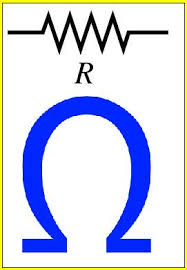Resistance:
Resistance may be defined as the property of a substance due to which it opposes (or restricts) the flow of electricity (or electrons) through it.
A resistor is a two-terminal electrical component that implements resistance in a electric circuit. The resistance (R) of a resistor is defined as the ratio of voltage across it (V) to current through it (I)
The practical unit of resistance is ohm. A conductor is said to have a resistance of one ohm if it permits one ampere current to flow through it when on volt is impressed across its terminals. For insulators whose resistance are very high, a much bigger unit is used ie. mega ohm or kilo ohm. In the case of very small resistances, smaller units like milliohm or micro ohm are used. The symbol for ohm is Ω.
Resistivity or Specific Resistance
The electrical resistance of a wire would be expected to be greater for a longer wire, less for a wire of larger cross sectional area, and would be expected to depend upon the material out of which the wire is made. An object of uniform cross section has a resistance proportional to its resistivity and length and inversely proportional to its cross-sectional area

The factor in the resistance which takes into account the nature of the material is the resistivity. Although it is temperature dependent, it can be used at a given temperature to calculate the resistance of a wire of given geometry. The inverse of resistivity is called conductivity. There are contexts where the use of conductivity is more convenient.
Temperature dependence
Resistance of wires, resistors, and other components change with temperature. Resistivity of metals typically increases as temperature is increased, while the resistivity of semiconductors typically decreases as temperature is increased.
Variation of resistance with temperature is given by:
where
 is called the temperature coefficient of resistance
is called the temperature coefficient of resistanceBased on resitance the substances may be classified as
- Conductors
- Semiconductors
- Insulators
Conductors:
Some materials are willing to let a few electrons move from molecule to molecule. Materials that let electrons move through them are called "conductors". It is due to the presence of a large number of free or loosely attached electrons in their atoms. Although some are better than others, most metals are good conductors of electricity. Silver, Gold, and Platinum are very good conductors but are expensive, so they are not often used. Copper and Aluminum are reasonably good conductors and are fairly inexpensive. Thus the wiring in our houses is copper, and the high voltage electric lines that we see crossing the country use aluminum cables.
Insulators:
Other substances keep their electrons under very tight control. Materials that do not let electrons move through them are called "insulators". Glass is an example of a type of material that keeps its electrons tightly controlled. Glass is made of silicon molecules, organized very tightly in to crystaline structures. Glass is an extremely good insulator. Many plastics are good insulators too. Plastics are cheap, flexible, and durable
Conductance: - In verse of resistance, unit is Siemens (old unit mho)
Electrical conductivity = σ = 1/ρ






No comments:
Post a Comment